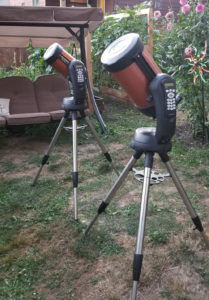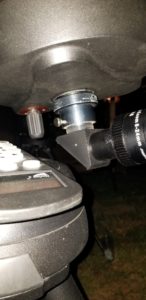By: Vlad Fedosov
Intro:
The Nexstar SE line of scopes are some of the most popular first “real” telescope for a lot of amateur astronomers. The scopes are made from 4-8” all featuring a single fork GOTO mount that will find any object in the night sky automatically. Perhaps the most popular units of the line are the Nexstar 6SE and the 8SE. When I had the opportunity to try out these two models side-by-side I jumped on the chance to put them through their paces. The 6SE weights in at 30lb whereas the 8SE weights in at 33lb fully assembled. These two scopes use the exact same mount with the only difference being the size of scope on it. So is the extra size and cost of the 8SE worth it? Let’s find out!

Testing:
I did the comparison of these small titans from Celestron in my mag 4 light-polluted back yard. I used the same 1.25” William Optics Dielectric Diagonal and Baader 24-8mm zoom eyepiece so that I can easily match up the magnifications in the two scopes. The night was moonless and Jupiter was still well placed and offered a natural object to start the comparison as it was getting dark. Before taking a look I had to do a star alignment to get the scopes GOTO system working. With most newer Celestrons all you need to do is point the telescope at 3 bright objects in the sky that can include stars, planets, and even the Moon. This is known as the Celestron Skyalign. The first time I did this with a previous Celestron I could not believe it can be that simple. You don’t need to know anything about the objects that you are pointing the scope to. It’s simply amazing!
Once the scopes where aligned I started with the 6SE and immediately noted the 4 moons of Jupiter and the two equatorial bands. The view was nice, but not releasing too much detail as the seeing on this night was not too hot. Switching over to the 8ES I was greeted with a similar but slightly brighter view. After some study, I could make out a few of the dimer bands on Jupiter but I did not see anything that the 8SE showed that I could not see in the 6SE as well. Given the average night of seeing in my location, I think these scopes would be quite comparable on the planets and the Moon. If your seeing is typically good you would benefit from a bit of extra resolution of the extra 2” of the aperture of the 8SE. There is one downside of the c8SE that was noted with planetary observing in that the mount does have substantially more vibration than with the 6SE when focusing or accidentally touching the eyepiece with your nose.
By this time it was totally dark and I could move onto taking a look at some deep-sky objects(DSO). The first DSO object that I slewed the scopes to was m57. The object was high overhead in the sky. Here was another area where the 8SE ran into trouble. The star diagonal was almost in contact with the mount when pointed up. This is not too huge of an issue if you are sticking with only using 1.25” peripherals but I’m sure that it would not clear the mount with a 2” setup. The 6SE still had ample space between the diagonal and mount, and overall just feels like its made for it. The 8SE certainly works on the mount but does feel like it’s a bit out of place… Back to m57. Both scopes showed this very bright planetary nebula with ease even under light pollution. The 8SE did display the object slightly brighter and it was quite apparent that the surrounding stars were also brighter.

Next up was globular cluster m13 in Hercules. Both scopes easily placed the object in the field of view(FOV) of the “finder” 40mm plossl. This object really showed off the extra light grasp of the 8SE well. The star arms of the globular were much easier to pick up with the 2” extra of aperture. It’s not to say that I saw much less with the 6SE but it was certainly a dimmer view and I had to use my averted vision more to bring in a similar amount of detail as the 8SE. The 8” was definitely the clear winner here.
Lastly, I decided to take a look at a dimmer DSO that I was actually imaging at the same time with my 12” LX-200 ACF in the observatory. This was NGC 7008, a dim planetary nebula in Cygnus. Slewing both scopes to the object I started with the 8SE and spotted it after a few seconds of looking around the FOV. It was a very dim ghostly round glow, but certainly there. No real detail was noted. I next took a look with the 6SE. At first, the object did not appear to be in the FOV, but after taking a closer look with my averted vision I was able to spot it. This object certainly displayed the extra horsepower of the 8” over the 6”. In all honesty, this was a good example of an object that would likely be spotted with the 8” and likely be missed with the 6” given the conditions I was observing it and depending on the experience level of the observer.
Conclusion:
So witch Nexstar SE scope should you buy? Well, there is, unfortunately, no simple answer. Overall the 8SE is a very worthwhile bump up in aperture if you are planning on doing some DSO observing. I do feel that the scope is really too big for the Nexstar SE mount and the 6SE pulls much further ahead in this area. Overall if you are set on getting a scope in the Nexstar SE line I would steer you towards the 6SE. It’s a very compact package and perfect for starting out doing visual observing. If you want the extra aperture of the 8” I would really look at getting it with a different mount package such as the CPC line or the AVX/CGEM mounts.
Support AVT-ASTRO
If you found this review helpful and are considering purchasing the product that was discusses please concider purchasing this item on Amazon using the link here. I get a small commission from Amazon and it really helps to pay for running this site!
